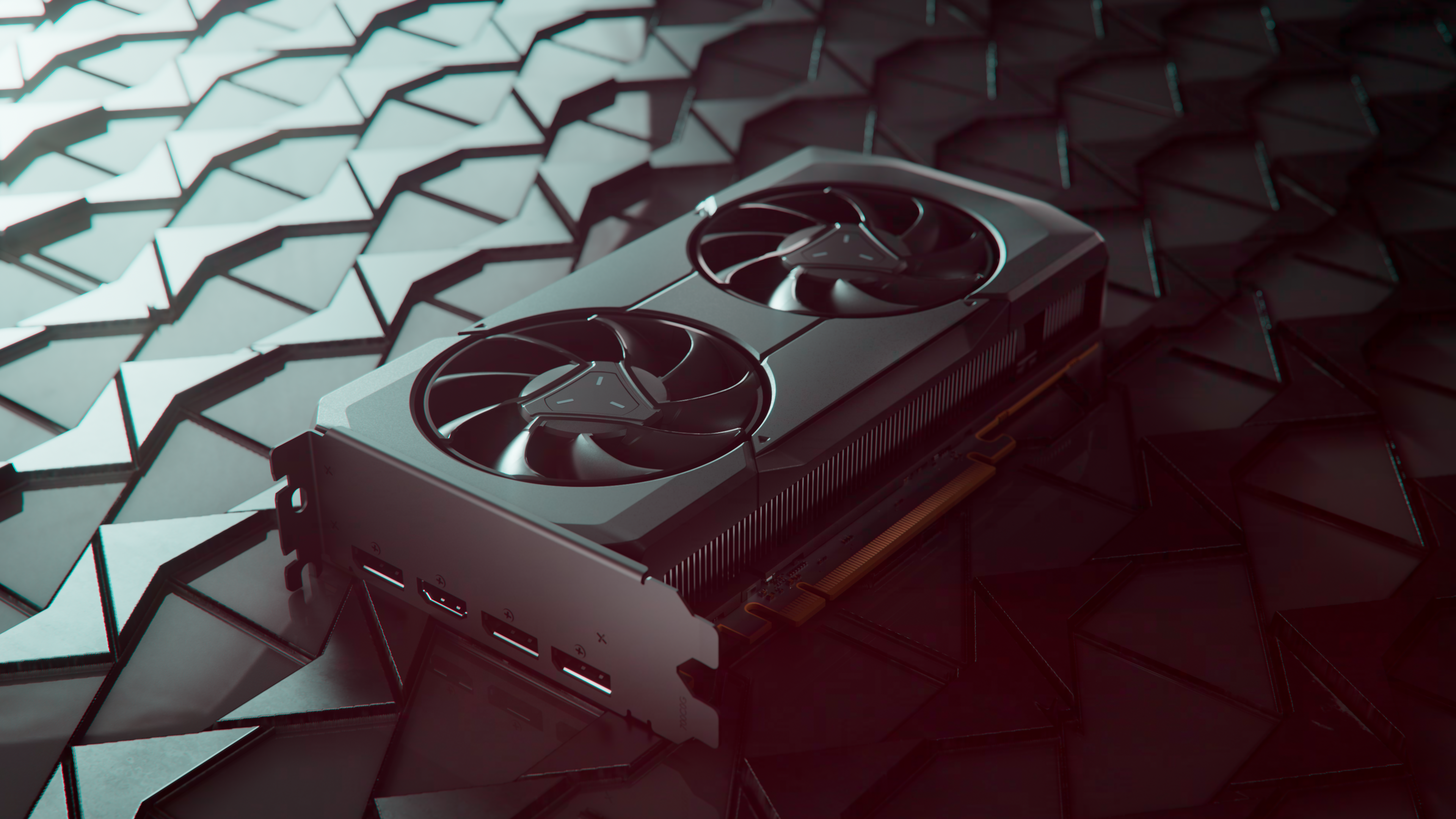AMD quietly launches Radeon RX 7400 8GB budget gaming GPU — RDNA 3 goes another rung lower on the ladder

AMD has introduced two new graphics cards based on the chipmaker's previous RDNA 3 architecture. The Radeon RX 7400 is an economical gaming graphics card targeting budget-conscious gamers, while the Radeon Pro W7400 caters to the professional and workstation markets.
The Radeon RX 7400 and Radeon Pro W7400 are based on AMD's Navi 33 (codenamed Hotpink Bonefish) silicon, which is likely the reason why the company decided to roll these out quietly without any fanfare. Navi 33 is also found in other lower-tier SKUs, including the Radeon RX 7600, Radeon RX 7600 XT, and the Radeon RX 7650 GRE. Navi 33, being the smallest silicon inside the RDNA 3 family, should be even cheaper to produce now, so it's reasonable to reuse it inside the Radeon RX 7400 and Radeon Pro W7400.
The Radeon RX 7400 features 28 RDNA 3 Compute Units (CUs), equivalent to 1,792 Stream Processors (SPs). This is 12.5% less than the Radeon RX 7600 in SPs, so the performance gap likely won't be significant. While both graphics cards' memory subsystems are similar, they're not equal.
AMD has equipped the Radeon RX 7400 with slower GDDR6 memory, clocked at 10.8 Gbps, compared to the 18 Gbps on the Radeon RX 7600. As a result, the former's memory bandwidth is 40% lower. The Radeon RX 7400 comes with DisplayPort 2.1 and HDMI 2.1 support.
Radeon RX 7400 and Radeon Pro W7400 Specifications
Graphics Card | Radeon RX 7600 | Radeon RX 7400 | Radeon Pro W7500 | Radeon Pro W7400 |
|---|---|---|---|---|
Architecture | Navi 33 | Navi 33 | Navi 33 | Navi 33 |
Process Technology | TSMC N6 | TSMC N6 | TSMC N6 | TSMC N6 |
Transistors (Billion) | 13.3 | 13.3 | 13.3 | 13.3 |
Die size (mm²) | 204 | 204 | 204 | 204 |
CUs | 32 | 28 | 28 | 28 |
GPU Shaders (ALUs) | 2,048 | 1,792 | 1,792 | 1,792 |
AI Accelerators | 64 | 56 | 56 | 56 |
Ray Accelerators | 32 | 28 | 28 | 28 |
Boost Clock (MHz) | 2,625 | ? | 1,700 | ? |
VRAM Speed (Gbps) | 18 | 10.8 | 16 | 10.8 |
VRAM (GB) | 8 | 8 | 8 | 8 |
VRAM Bus Width | 128 | 128 | 128 | 128 |
Infinity / L2 Cache (MB) | 32 | 32 | 32 | 32 |
Render Output Units | 64 | 64 | 64 | 64 |
Texture Mapping Units | 128 | 112 | 112 | 112 |
TFLOPS FP32 (Boost) | 21.5 | ? | 12.19 | ? |
TFLOPS FP16 (FP8) | 43 | ? | 24.37 | ? |
Bandwidth (GB/s) | 288 | 173 | 256 | 173 |
TBP/TGP (W) | 165 | 55 | 70 | 55 |
Launch Date | May 2023 | August 2025 | August 2023 | August 2025 |
Launch MSRP | $269 | ? | $429 | ? |
The Radeon RX 7400 doesn't need any external power connectors. The Navi 33-powered graphics card has a TBP (Typical Board Power) of 55W, so a 450W power supply is sufficient as a minimum. AMD hasn't confirmed whether there will be custom designs, but based on the description, the graphics card listed on AMD's website adheres to a single-slot design with a length of 6.65 inches (167mm).
Meanwhile, the Radeon Pro W7400 is the workstation variant of the Radeon RX 7400, sharing identical specifications. AMD positions the Radeon Pro W7400 under the existing Radeon Pro W7500. Examining the specifications, the first is essentially a lower-binned version of the second.
Both have the same number of CUs and memory capacity. However, the Radeon Pro W7400 has the same 10.6 Gbps memory as the Radeon RX 7400, resulting in the same bandwidth. It's 32% lower than the Radeon Pro W7500. The Radeon Pro W7500 was already an energy-efficient workstation graphics card, but the Radeon Pro W7400's compromises have allowed AMD further to reduce the TBP by 21% on the latter.
Get Tom's Hardware's best news and in-depth reviews, straight to your inbox.
The Radeon Pro W7400 features a half-height form factor with a single-slot design, measuring 6.6 inches (168mm) in length. It has the same TBP as the Radeon RX 7400, so no external power connectors are required. As for display outputs, the Radeon Pro W7400 sports four mini DisplayPort 2.1 outputs.
AMD hasn't revealed the pricing for the Radeon RX 7400 or Radeon Pro W7400. Nonetheless, the Radeon RX 7600 and Radeon Pro W7500 launched at $269 and $429, respectively, so the new Navi 33 offerings should be more affordable.
Follow Tom's Hardware on Google News to get our up-to-date news, analysis, and reviews in your feeds. Make sure to click the Follow button.

Zhiye Liu is a news editor, memory reviewer, and SSD tester at Tom’s Hardware. Although he loves everything that’s hardware, he has a soft spot for CPUs, GPUs, and RAM.
-
King_V Definitely curious as to the performance on the 7400, relative to the 6400 and 6500, for old compact office-type PCs.Reply
Given that 55w cards have previously been made that are single slot-and low profile (RX 6400, R7 250E/HD 7750), this should be a no-brainer for the 7400 as an available option. -
COLGeek Seems like a smart move to fill that need of the MANY users who want something more than integrated graphics, but less than an expensive gaming oriented GPU.Reply
These products are not targeted at the typical Tom's Hardware member. -
Pierce2623 Realistically, if it’s like only $150, it would be a new high point for that segment. It’s WAY better than the rx 6400.Reply -
Amdlova Tried to use the 2500k on youtube almost 100% processor usage to transcode the av1 codec and barely hiting the 30 fps.Reply
These small graphics are a nice boost to an old machine. -
Notton If it's Navi33, it should support AV1 encode/decode, unlike the really crappy Navi24.Reply
Unless AMD disabled those features, but we shall see. -
pug_s Reply
I don't know if it can be compared to a 6400 or 6500. It looks like the same die as the 7600 but with maybe at most 50% of the cu's cut off so performance won't be that bad, no?King_V said:Definitely curious as to the performance on the 7400, relative to the 6400 and 6500, for old compact office-type PCs.
Given that 55w cards have previously been made that are single slot-and low profile (RX 6400, R7 250E/HD 7750), this should be a no-brainer for the 7400 as an available option. -
palladin9479 I suspect not many of these will be sold to end users and instead make their way into OEM and Office PC's. Things like MS Teams and Zoom perform much better with a real GPU installed for remote calls.Reply